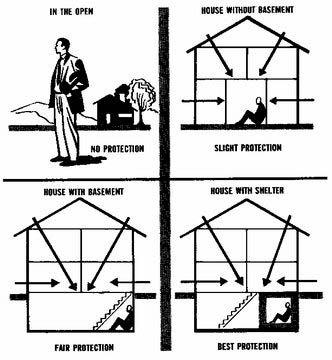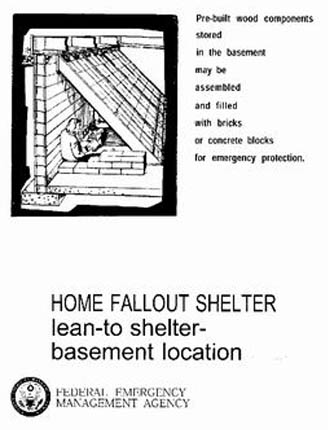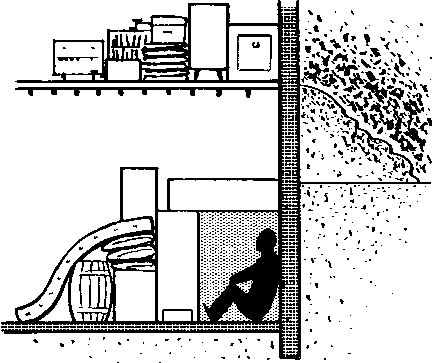|
|
 |
 |
Reply
 | | (1 recommendation so far) | Message 1 of 2 in Discussion |
| From:   Advnelisgi® (Original Message) Advnelisgi® (Original Message) | Sent: 1/25/2006 1:41 AM |
WHAT TO DO IF A NUCLEAR DISASTER IS IMMINENT!
This guide is for families preparing for imminent terrorist or strategic nuclear attacks
with expected severe destruction followed by widespread radioactive fallout downwind. | IF ONLY A 'Dirty Bomb' Attack (Not the vastly more devastating nuclear weapon blasts with fallout discussed below.) - You can expect localized and downwind contamination from the explosion and dispersed radioactive materials. If you are near enough to see or hear any local bomb blast, assume that it includes radiological or chemical agents. You should move away from the blast area as quickly as possible. If the wind is blowing toward you from the direction of the blast, travel in a direction that keeps the wind to your left or right as you move away from the blast area. If possible cover your face with a dust mask or cloth to avoid inhaling potentially radioactive dust. Upon reaching a safe location, remove your outer clothing outside and shower as soon as possible. Refer to local news sources for additional instructions about sheltering or evacuation. The government is better prepared to direct and assist the public in a 'dirty bomb' incident, unlike an actual nuclear weapon attack discussed below. | In a national crisis of imminent nuclear weapon attacks, read all the way through this guide first, THEN TAKE EFFECTIVE PROTECTIVE ACTION WITH CONFIDENCE... FAST! #1 - STAY OR GO? You must decide FIRST if you need to prepare where you are, or attempt evacuation. The nature of the threat, your prior preparations, and your confidence in your sources of information should direct your decision. If you know already you will be preparing to stay at your own home or, at least, the immediate local area, go now to #2 below. If you are considering evacuation, your decision requires a very high confidence that it is worth the risk. You do not want to get stuck between your current location and your hoped for destination, as there will probably be no easy getting back. If you fail to get to your destination, you may be exposed without shelter, in a dangerous situation with little effective law enforcement, perhaps among panicked hordes of refugees. Whatever supplies you have may be limited then to what you can carry on foot. IF you are in a big city or near a military target, AND you have relatives or friends in the country that you know are awaiting you, AND the roads between you and them are clear, AND the authorities are not yet restricting traffic, AND you have the means and fuel, evacuation may be a viable option for a limited time. DO NOT attempt evacuation if all of the above is not clearly known, or if the situation is deteriorating too quickly to make the complete trip. You do not want to get stuck and/or become a refugee being herded along with panicked masses. If evacuation is truly a viable option, do not wait - GO NOW! Do so with as many of the supplies listed on the last page as possible. Better to be two days too early in arriving than two hours too late and getting snagged mid-way, potentially exposing your family to a worse fate than having stayed where you were. Because of the very real danger of getting caught in an evacuation stampede that stalls, almost all families will be better off making the best of it wherever they currently are. #2 - WHAT YOU NEED TO DO FIRST Because time is of the essence, you need to first delegate and assign to different adult family members specific tasks so they can all be accomplished at the same time. Your first priorities to assure your family survival are Shelter, Water, and Food/Supplies. While some are working on the water storage and shelter at home, others need to be acquiring, as much as possible, the food and supplies. #3 - FOOD/SUPPLIES Because much of the food and supplies listed on the last page of this guide may quickly become unavailable, quantities restricted, and/or the streets and stores may become un-safe soon, you need to assign someone NOW to immediately go to the stores with that list! Get cash from the bank and ATM's first, but try and use credit cards at the stores, if at all possible, to preserve your cash. #4 - WATER With one or more adults now heading to the stores with the list on the last page, those remaining need to begin storing water IMMEDIATELY! Lack of clean water will devastate your family much more quickly and more severely than any lack of food. Without water for both drinking and continued good sanitary practices in food preparation and for bathroom excursions (which will inevitably be much less sanitary than normal), debilitating sickness could rampage through your household with little hope of prompt medical attention. That is a highly likely but, avoidable, disaster, ONLY IF you have enough water. Every possible container needs to be filled with water RIGHT NOW! It will be very hard to have stored too much water. When the electricity/pumps go down or everybody in your community is doing the same thing, thus dropping the water pressure, that's it, what you've got is all you might be getting for a very long time. Empty pop bottles (1-3 liter) are ideal for water storage, also filling up the bathtub and washing machine. (Remember, later you'll have some in your hot water tank.) If you have any kiddie pools or old water beds, pull them out and fill them up, too. (Water from a water bed should be used only for bathing or cleaning, not for drinking as it may contain traces of algicide and/or fungicides.) Anything and everything that'll hold water needs to be filled up quickly RIGHT NOW!! One of the shopping items listed on the last page is new garbage cans and liner bags which you'll also use for storing water. If you can't get any more new cans, you could clean out an existing garbage can and scrub it throughout with bleach, then put in a new garbage bag liner and fill it with water. (Use two liners if they are very thin/flimsy.) Choose well where you fill up garbage cans with water because they won't easily be moved once full and many of them together could be too heavy for some upper floor locations. Ideally, they need to be very near where your shelter will be constructed and can actually add to its shielding properties, as you'll see below. BE ASSURED, YOU CANNOT STORE AND HAVE TOO MUCH WATER! Do not hesitate, fill up every possible container, RIGHT NOW! #5 - SHELTER The principles of radiation protection are simple - with many options and resources families can use to prepare or improvise a very effective shelter. You must throw off the self-defeating myths of nuclear un-survivability that may needlessly seal the fate of less informed families. Radioactive fallout is the particulate matter (dust) produced by a nuclear explosion and carried high up into the air by the mushroom cloud. It drifts on the wind and most of it settles back to earth downwind of the explosion. The heaviest, most dangerous, and most noticeable fallout, will 'fall out' first close to ground zero. It may begin arriving minutes after an explosion. While the smaller and lighter dust-like particles will typically be arriving hours later, as they drift much farther downwind, often for hundreds of miles. As it settles, whether you can see it or not, fallout will accumulate and blow around everywhere just like dust or light snow does on the ground and roofs. Wind and rain can concentrate the fallout into localized 'hot spots' of much more intense radiation with no visible indication of its presence. This radioactive fallout 'dust' is dangerous because it is emitting penetrating radiation energy (similar to x-ray's). This radiation (not the fallout dust) can go right through walls, roofs and protective clothing. Even if you manage not to inhale or ingest the dust, and keep it off your skin, hair, and clothes, and even if none gets inside your house, the radiation penetrating your home is still extremely dangerous, and can injure or kill you inside. Radioactive fallout from a nuclear explosion, though very dangerous initially, loses its intensity quickly because it is giving off so much energy. For example, fallout emitting gamma ray radiation at a rate of 500 R/hr (fatal with one hour of exposure) shortly after an explosion, weakens to only 1/10th as strong 7 hours later. Two days later, it's only 1/100th as strong, or as deadly, as it was initially. That is really very good news, because our families can readily survive it IF we get them into a proper shelter to safely wait it out as it becomes less dangerous with every passing hour. What stops radiation, and thus shields your family, is simply putting mass between them and the radiation source. Like police body armor stopping bullets, mass stops (absorbs) radiation. The thicker the mass, the more radiation it stops. Also, the denser (heavier) the mass used, the more effective it is with every inch more you add to your fallout shelter. The thickness in inches needed to cut the radiation down to only 1/10th of its initial intensity for different common materials is: Steel 3.3", concrete 11", earth 16", water 24", wood 38", etc. The thickness required to stop 99% of the radiation is: 5" of steel, 16" of solid brick or hollow concrete blocks filled with mortar or sand, 2 feet of packed earth or 3 feet if loose, 3 feet of water. You may not have enough steel available, but anything you do have will have mass and can be used to add to your shielding - it just takes more thickness of lighter wood, for example, than heavier earth, to absorb and stop the same amount of radiation. Increasing the distance between your family and the radiation outside also reduces the radiation intensity. The goals of your family fallout shelter are: - To maximize the distance away from the fallout 'dusting' outside on the ground and roof
- To place sufficient mass between your family and the fallout to absorb the deadly radiation
- To make the shelter tolerable to stay in while the radiation subsides with every passing hour
While a fallout shelter can be built anywhere, you should see what your best options are at home or nearby. Some structures already provide significant shielding or partial shielding that can be enhanced for adequate protection. If you do not have a basement available, you can still use the techniques shown below in any above ground structure, but you'll need to use more mass to achieve the same level of shielding. You may consider using other solid structures nearby, especially those with below ground spaces, such as commercial buildings, schools, churches, below ground parking garages, large and long culverts, tunnels, etc.. Some of these may require permissions and/or the acquiring of additional materials to minimize any fallout drifting or blowing into them, if open ended. Buildings with a half-dozen or more floors, where there is not a concern of blast damage, may provide good radiation protection in the center of the middle floors. This is because of both the distance and the shielding the multiple floors provide from the fallout on the ground and roof. Bottom Line: choose a structure nearby with both the greatest mass and distance already in place between the outside, where the fallout would settle, and the shelter inside. | If you have a basement in your home, or at a nearby relatives' or friends' house that you can use, your best option is probably to fortify and use it, unless you have ready access to a better/deeper structure nearby. For an expedient last-minute basement shelter, push a heavy table that you can get under into the corner that has the soil highest on the outside. The ground level outside ideally needs to be above the top of the inside shelter. If no heavy table is available, you can take internal doors off their hinges and lay them on supports to create your 'table'. Then pile any available mass on and around it such as books, wood, cordwood, bricks, sandbags, heavy furniture, full file cabinets, full water containers, your food stocks, and boxes and pillow cases full of anything heavy, like earth. Everything you could pile up and around it has mass that will help absorb and stop more radiation from penetrating inside - the heavier the better. However, be sure to reinforce your table and supports so you do not overload it and risk collapse. |  | | Leave a small crawl-through entrance and more mass there that can be easily pulled in after you to seal it up. Have at least two gaps or 4-6" square air spaces, one high at one end and one low at the other. Use more if crowded and/or hotter climate. A small piece of cardboard can help fan fresh air in if the natural rising warmer air convection current needs an assist moving the air along. This incoming air won't need to be filtered if the basement has been reasonably sealed up, however any windows or other openings will require some solid mass coverage to assure they stay sealed and to provide additional shielding protection for the basement. More details on this in the next (#6) section. With more time, materials, and carpentry or masonry skills, you could even construct a more formal fallout shelter, such as the lean-to shown to the right, but you should pile up much more mass than what little is shown here. An effective fallout shelter constructed in a basement may reduce your radiation exposure 100-200 fold. Thus, if the initial radiation intensity outside was 500 R/hr (fatal in one hour), the basement shelter occupants might only experience 5 R/hr or even less, which is survivable, as the radiation intensity will be decreasing with every passing hour. |  | | Adding mass on the floor above your chosen basement corner, and outside against the walls opposite your shelter, can dramatically increase your shielding protection. Every inch thicker adds up to more effective life-saving radiation shielding. As cramped as that crawl space fallout shelter might seem, the vital shielding provided by simply moving some mass into place could be the difference between exposure to a lethal dose of radiation and the survival of your family. The majority of people requiring any sheltering at all will be many miles downwind, and they will not need to stay sheltered for weeks on end. In fact, most people will only need to stay sheltered full-time for a few days before they can start coming out briefly to attend to quick essential chores. Later, they can begin spending ever more time out of the shelter daily, only coming back in to sleep. As miserable as it might seem now, you and your family can easily endure that, especially compared to the alternative. |  | It's really not so difficult to build an effective family fallout shelter, not to get it done... <NOBR>RIGHT NOW!</NOBR>
Part One Part Two next |
|
|
|
 Free Forum Hosting
Free Forum Hosting